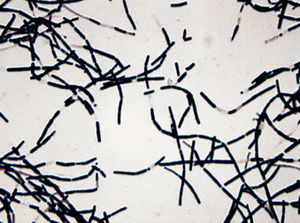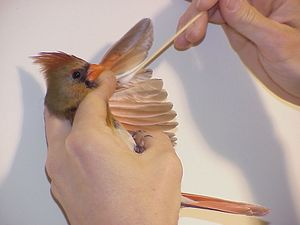Bacillus licheniformis: Difference between revisions
| Line 65: | Line 65: | ||
''Bacillus licheniformis'' is commonly associated with food spoilage and poisoning. It causes bread spoilage, or more specifically, a condition called "ropy bread" (1). Contamination will make the bread sticky and stringy; the ropy bread will also start to develop a strong odor after contamination. Rope spores is what causes the spoilage; unfortunately these spores do not get killed during the baking process. | ''Bacillus licheniformis'' is commonly associated with food spoilage and poisoning. It causes bread spoilage, or more specifically, a condition called "ropy bread" (1). Contamination will make the bread sticky and stringy; the ropy bread will also start to develop a strong odor after contamination. Rope spores is what causes the spoilage; unfortunately these spores do not get killed during the baking process. | ||
It can also cause food-borne gastro-enteritis, which is infection of the gut that can lead to a life threatening condition called Septicaemia. Septicaemia is blood poisoning, it is classified as having a large amount of bacteria in the blood. Dairy products are at increased risk of being contaminated with toxin-producing isolates of ''Bacillus licheniformis.'' Cooked meats, vegetables, and processed baby foods are also at risk. | It can also cause food-borne gastro-enteritis, which is infection of the gut that can lead to a life threatening condition called Septicaemia. Septicaemia is blood poisoning, it is classified as having a large amount of bacteria in the blood. Dairy products are at increased risk of being contaminated with toxin-producing isolates of ''Bacillus licheniformis.'' Cooked meats, raw milk, vegetables, and processed baby foods are also at risk. (4) | ||
The symptoms include stomach pains, (acute) diarrhea, and possible vomiting. These have an onset time of 2-14 hours and last no longer than 36 hours. | The symptoms include stomach pains, (acute) diarrhea, and possible vomiting. These have an onset time of 2-14 hours and last no longer than 36 hours. | ||
Revision as of 06:03, 5 June 2007
A Microbial Biorealm page on the genus Bacillus licheniformis
Classification
Higher order taxa
cellular organisms; Bacteria; Firmicutes; Bacilli; Bacillales; Bacillaceae; Bacillus; Bacillus licheniformis
Species
|
NCBI: Taxonomy |
Bacillus licheniformis
Description and significance
Bacillus licheniformis is a bacterium that is commonly found in soil and bird feathers. Birds that tend to stay on the ground more than the air (i.e. sparrows)and on the water (i.e. ducks) are common carriers of this bacterium; it is mostly found around the bird's chest area and back plumage.
Bacillus licheniformis is part of the subtilis group along with Bacillus subtilis and Bacillus pumilus. These bacteria are commonly known to cause food poisoning and food spoilage. Bacillus licheniformis also is known for contaminating dairy products. Food borne outbreaks usually involve cases of cooked meats and vegetables, raw milk, and industrially produced baby food contaminated with Bacillus licheniformis. (4)
This bacterium, although detrimental, can be modified to become useful. Researchers are trying to turn bird feathers into a nutritious livestock feed by fermenting non-digestable proteins on bird feathers with Bacillus licheniformis. There is also research about the possibility that Bacillus licheniformis causes changes in color in birds' feathers; this will provide information on the evolution of molting. Also, cultures of Bacillus licheniformis are made to retain its protease, which is in turn used in laundry detergent.
Genome structure
The complete nucleotide sequence of Bacillus licheniformis consists of the ATCC 14580 genome, which has a circular chromosome of 4,222,336 bp (base pairs) which in itself contains 4,208 predicted protein-coding genes (average size of 873 bp), 7 rRNA operons, and 72 tRNA genes. The GC content is 46.2% and no plasmids were detected. (3)
The chromosome of Bacillus licehniformis has large regions that are similar to Bacillus subtilis and Bacillus halodurans. Since about 80% of the coding sequence of Bacillus licheniformis contain Bacillus subtilis orthologs, it is considered part of the subtilis group. But, although similar to Bacillus subtilis, they differ in the amount and location of prophages, transposable elements, extracellular enzymes, and secondary metabolic pathway operons. (3)
Cell structure and metabolism
Bacillus licheniformis is a rod-shaped, Gram-positive bacterium. It tends to form spores in soil which makes it desirable to be used for the industrial purposes such as the production of enzymes, antibiotics, and small metabolites. It produces an variety of extracellular enzymes that is associated with the cycling of nutrients in nature.
Its optimal growth temperature is 50°C, but it can also survive at much higher temperatures. Its optimal temperature for enzyme secretion is 37°C. This bacterium can survive harsh environments by turning into spore-form; when conditions are good, it will turn back into a vegetative state.
Bacillus licheniformis produces a protease that can survive at high pH levels. This protease is a desired ingredient in laundry detergent due to its ability to be used in low temperatures, which prevents shrinkage and fading colors.
Ecology
Bacillus licheniformis forms spores in soil which makes it desirable to be used for the industrial purposes such as the production of enzymes, antibiotics, and small metabolites. A pathway that leads to endospore formation is initiated when the bacterium is starved. Endospore formation is actually desired and serves as a great example of prokaryotic development and differentiation. These spores are quite tolerant of heat, cold, radiation, and other environmental stresses; but under good conditions, the spores will germinate and produce vegetative cells.
B. licheniformis produces an variety of extracellular enzymes that is associated with the cycling of nutrients in nature. It is an apathogenic soil organism that is mostly associated with plant and plant materials in nature. Although the most common thing to isolate this bacterium from is soil, it is believed that B. licheniformis can actually be isolated from practically anywhere since it produces highly resistant endospores that are spread around with dust.
Ecologists are studying the effects of B. licheniformis on bird feathers. It is believed that this bacterium is involved in the evolution of molting and patterns of color in birds due to its feather degrading capability.
B. licheniformis is also known to cause food poisoning in humans; especially high in contamination rates are products such as raw milk, dairy, vegetables, processed baby foods, and cooked meats.
Pathology
Bacillus licheniformis is commonly associated with food spoilage and poisoning. It causes bread spoilage, or more specifically, a condition called "ropy bread" (1). Contamination will make the bread sticky and stringy; the ropy bread will also start to develop a strong odor after contamination. Rope spores is what causes the spoilage; unfortunately these spores do not get killed during the baking process.
It can also cause food-borne gastro-enteritis, which is infection of the gut that can lead to a life threatening condition called Septicaemia. Septicaemia is blood poisoning, it is classified as having a large amount of bacteria in the blood. Dairy products are at increased risk of being contaminated with toxin-producing isolates of Bacillus licheniformis. Cooked meats, raw milk, vegetables, and processed baby foods are also at risk. (4)
The symptoms include stomach pains, (acute) diarrhea, and possible vomiting. These have an onset time of 2-14 hours and last no longer than 36 hours.
Bacillus licheniformis, although usually associated with the gut and gastrointestinal tract, can also cause distress in other parts of the body. It can cause ophthalmitis, which is the inflammation of the eye. It can even go as far as causing abortions in pregnancies.
Application to Biotechnology
Researchers are trying to recycle bird feathers by turning them into nutritious food for livestock. As mentioned, Bacillus licheniformis is commonly found on bird feathers; by fermatation with B. licheniformis, the large amounts of non-digestible proteins found in the feathers can turn into a feather meal for livestock. This is desired because it is cheap and nutritious.
B. licheniformis can also give more information about the evolution of molting and patterns of color in birds due to its feather degrading capability. Ecologists are looking for signs of association between the plumage feathers and B. licheniformis activity.
B. licheniformis is also an important ingredient in laundry detergent. Since it can grow in alkaline conditions, it produces a protease that can survive at high pH levels. The protease has an optimum pH at around 9 and 10, which is desirable since it can remove protein-comprised dirt in clothes. Researchers culture and isolate this protease to add it into detergents. This protease prevents shrinkage and fading colors since it allows lower temperatures to be used, which in turn lowers energy use as well.
B. licheniformis is used to make the antibiotic Bacitracin. Bacitracin is composed of a mixture of the cyclic polypeptides that B. licheniformis produces; ironically the purpose of Bacitracin is to inhibit the growth of B. licheniformis. Bacitracin lyses the proplasts of B. licheniformis in the presence of cadmium or zinc ions.
Current Research
Bacillus licheniformis is a spore-forming soil organism that contributes to nutrient cycling and has antifungal activity. There is current research on Bacillus licheniformis (strain SB3086) and its effects as a microbial fungicide. Novozymes Biofungicide Green Releaf contains Bacillus licheniformis strain SB3086 as an active main ingredient. This fungicide can be used on lawns, conifers, tree seedlings, ornamental turf and ornamental plants in outdoor, greenhouse, and nursery sites. There are concerns regarding the safety of this fungicide. Reports about Bacillus licheniformis having detrimental effects on insect, avian, plant, and estuarine marine species are fortunately almost non-existent. There have been reports of reproductive failure and mastitis caused by this bacterium in cattle, sheep and swine. It fortunately does not have any detrimental effects on endangered species.
There is an increased interest in using a protease isolated from Bacillus licheniformis in laundry detergents. Since this bacterium grows in alkaline conditions, it produces a desirable protease that can survive at high pH levels. This protease is an active ingredient in laundry detergents, removing protein-comprised dirt in clothes. The desirable properties of this protease are its prevention of clothes shrinkage and fading colors due to its capability to be used at lower temperatures. The Research/Technology Invention Award 2006 was given to members of the BiotechGenoMik project on Bacillus licheniformis; they invented a system for controlling industrial fermentation, which they named BioChip. This system uses DNA-based diagnostic tool to monitor fermentation processes such as the production of enzymes for Henkel laundry detergents.
Currently there are many electrical techniques for food processing, one such example is Ohmic heating. Ohmic heating has potential uses such as blanching, evaporation and pasteurization of food; it is a high temperature, short time, and a purely bulk heating method. There are increased concerns regarding microbial contaminations, from such bacteria as E.coli and Bacillus licheniformis, when it comes to food processing. Current research try to find the "death kinetics" (2) of these bacteria. Death kinetics, in this case, involves the intensity of heat treatments and their correlation with the rate of death of a bacterium. The death kinetics for Bacillus licheniformis ATCC® 14580 spores in cloudberry jam was examined under ohmic heat inactivation and conventional heat inactivation. Results of studies show that the ohmic heating has a quicker death kinetic rate, meaning shorter and less aggressive treatments can be used to kill off Bacillus licheniformis.
References
(9) http://www.epa.gov/pesticides/biopesticides/ingredients/tech_docs/brad_006492.pdf
Edited by Thu Mai, student of Rachel Larsen and Kit Pogliano


